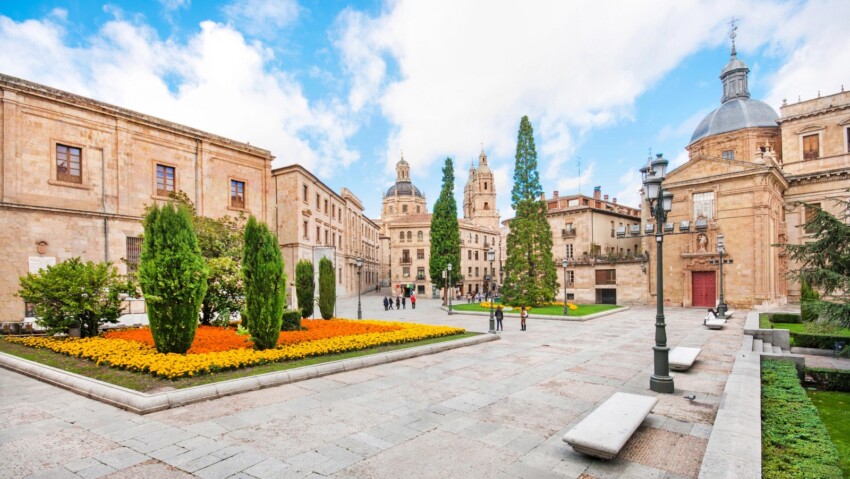

A city of rare beauty, Salamanca is a true pearl of Spanish tourism and the ideal destination for a romantic holiday, a weekend of art and culture or the start of an itinerary in central Spain. Only 200 km from Madrid, it is well connected and easily accessible by car or public transport.
Home to Spain’s oldest university and the cradle of the Spanish language (the first Spanish grammar was compiled here), it is without doubt one of Spain’s most enchanting medieval cities.
The magnificent Plaza Mayor, dramatically lit up at night, and the richly decorated façade of the university are two wonders that, once seen, remain forever among the most beautiful travel memories.
The surroundings, with typical villages scattered here and there and the Sierra de Francia and Sierra de Gredos mountains, are no less fascinating.
The centre of Salamanca is small and you can easily get around on foot. Here are the attractions not to be missed!
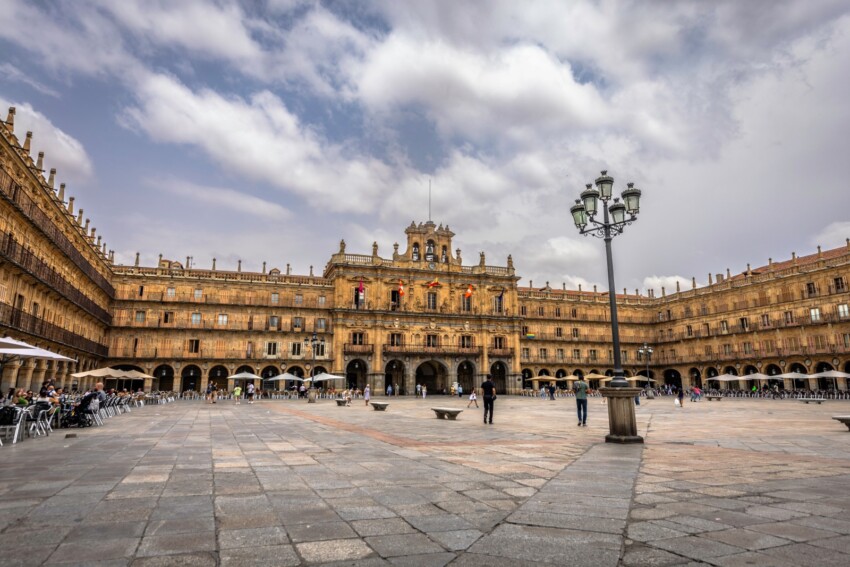
The magnificent Plaza Mayor in Salamanca is considered by many to be the most beautiful historical square in Spain and one of the most beautiful in Europe.
Built between 1729 and 1755 to a design by Alberto Churriguera, it is a pedestrian square whose shape vaguely resembles a square, flanked by stately palaces, one of which is home to the town hall while the others house cafés, ice-cream parlours, jewellery and souvenir shops on the ground floor.
In spite of the rich Baroque decoration of the palaces, the whole is harmonious and particularly atmospheric. The atmosphere is always lively because the square is the main meeting point of the city: everyone, from the young to the old, meet here for an afternoon or an evening of chatting, which may then continue elsewhere.
The beauty of this very elegant square becomes pure magic at sunset when it is spectacularly illuminated: the view of Plaza Mayor at night will surely be one of the best memories of your holiday!
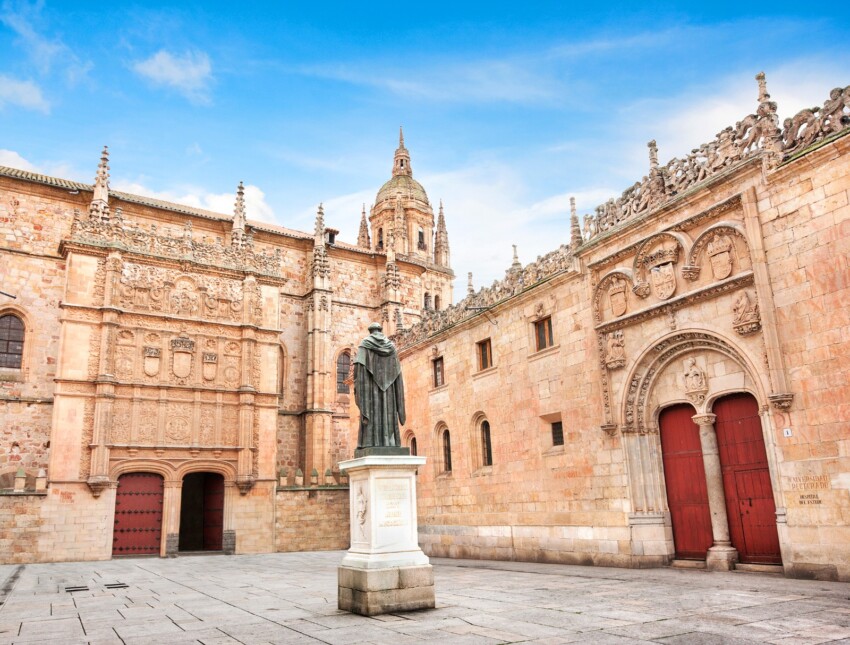
It carries 800 years of history on its shoulders but its beauty is eternal: the historic seat of the University of Salamanca, the oldest in Spain and one of the oldest in Europe, is an architectural marvel.
The stunning sandstone exterior façade is a triumph of sculptural decoration depicting mythological heroes, religious scenes and heraldic coats of arms; above all, the busts of the Catholic kings Fernando and Isabella dominate.
Inside the building is the oldest library in Europe, where 2800 dusty manuscripts are kept; if you find them uninteresting, take a look at the beautiful wooden ceiling.
Can you decipher the symbols inlaid in the balustrade of the Escalera de la Universidad? It is said that deciphering them is a symbol of the quest for knowledge. According to another legend, there is an inlaid frog on the main façade of the building and being able to spot it brings good luck.
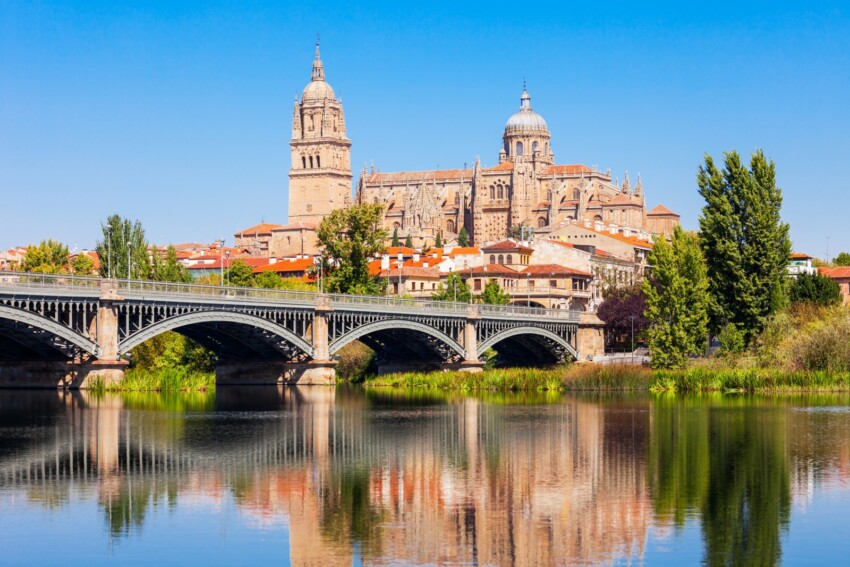
Salamanca boasts two cathedrals, which are referred to by a name that makes it immediately obvious which was built first and which later: Catedral Vieja and Catedral Nueva!
The Catedral Vieja dates back to the 12th century and mixes Gothic and Byzantine elements with an essentially Romanesque layout. The magnificent 15th-century altarpiece is decorated with 53 scenes from the life of Mary and Christ, with a central panel depicting the Last Judgement.
In the Capilla de Anaya you can admire an original alabaster tomb and an ancient Mudejar organ.
The Catedral Nueva is a late Gothic church that dominates the city with its imposing tower and elaborate dome in ‘churrigueresque’ style (a very special version of Baroque).
The view of the interior of the cathedral is no less impressive, with elaborate wooden choir stalls and the retrochoir, the main chapel and the splendid Renaissance gates, especially the Puerta del Nacimiento on the western side.
The Catedral Nueva was the subject of restoration work in 1992. Apparently, some slightly prankish workers made a nice addition to the decorations of the Puerta de Ramos, overlooking the Plaza de Anaya. It would be a small astronaut and an ice cream cone: can you see them?
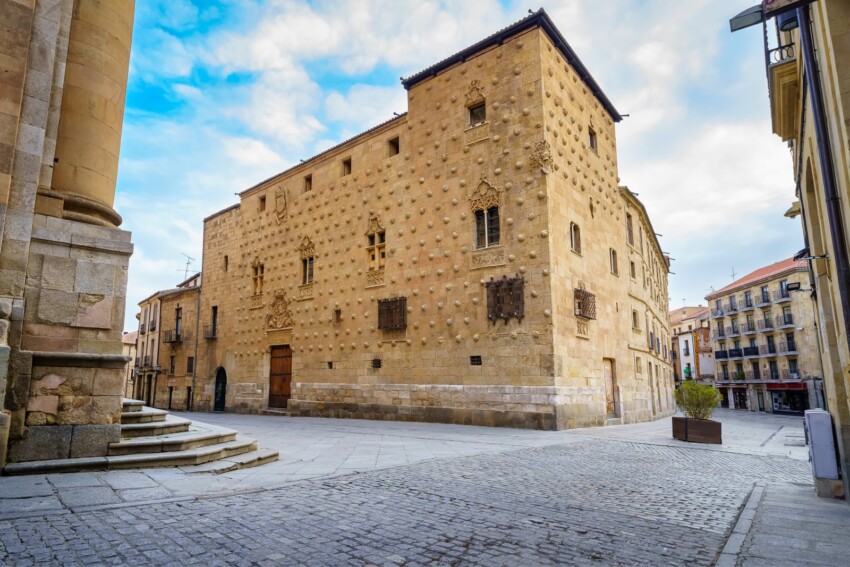
Listing all the beautiful historical palaces in the centre of Salamanca is an impossible task, we will just point out two that you should not miss.
One of Salamanca’s most bizarre historical palaces is Casa de las Conchas4, once the private residence of Dr Rodrigo Maldonado de Talavera, a doctor at the court of Queen Isabella.
The 300 shells that cover the façade of the building are an obvious reminder of the Order of Santiago to which the owner of the house also belonged: the shell is in fact the symbol of the order.
Today, the building houses a public library accessed through an inner courtyard with a fountain and an elegant colonnade.
Take a look at the façade of Monterrey Palace5, a royal summer residence built in the 16th century and a fine example of Spanish Renaissance architecture. Unfortunately, the building is not open to the public so you have to make do with the exterior façade.
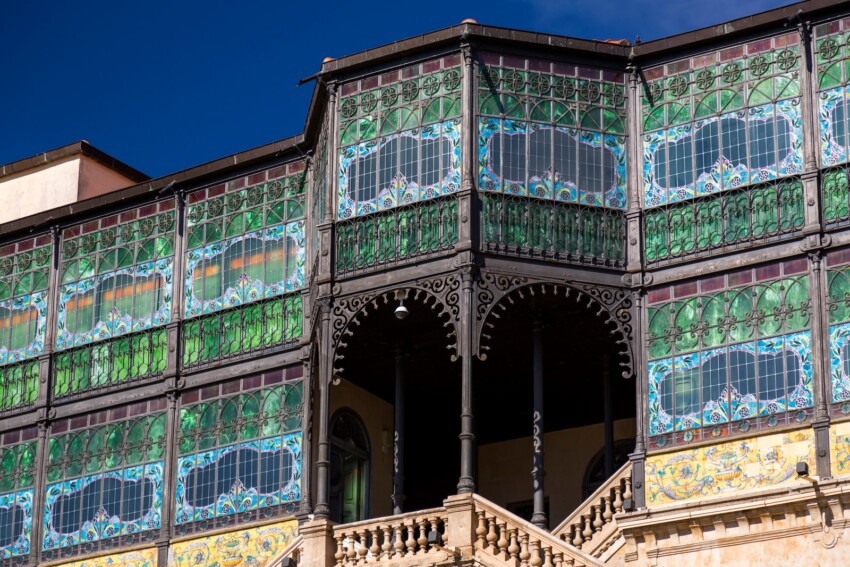
We recommend the following museums in Salamanca to history and culture enthusiasts:
The Convent of San Esteban is a magnificent example of Plateresque architecture. Its façade, considered a ‘stone retable’, is richly decorated. The interior has a magnificent cloister and a monumental staircase. It was here that Christopher Columbus found support for his planned voyage to the Indies.
The Garden of Calisto and Melibea is a romantic medieval garden that offers beautiful views of the cathedral. This green space is linked to the famous opera ‘La Celestina’ and is an oasis of peace in the historic centre.
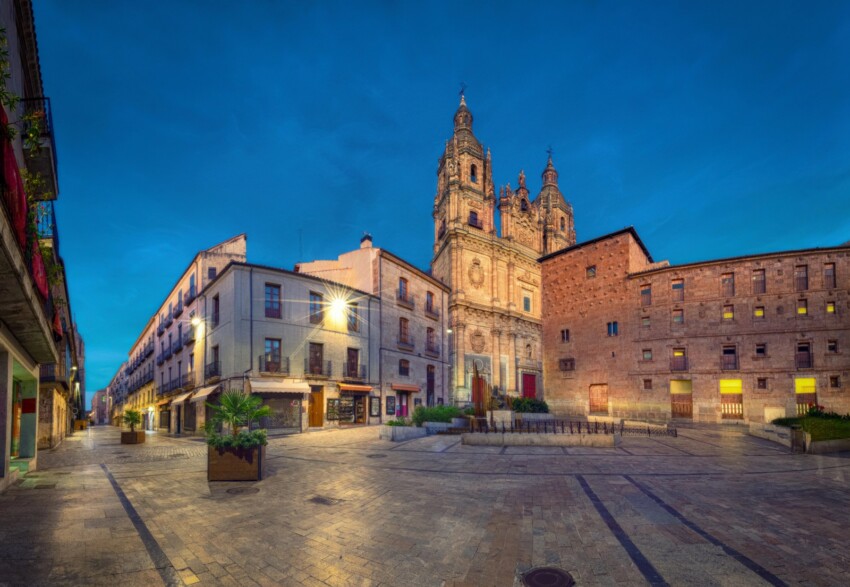
The Real Clerecía is probably the most impressive church in Salamanca after the two cathedrals: it is a monumental Baroque church built in the early 17th century.
Now the seat of the Pontifical University, it can be visited on a guided tour that includes a climb to the bell tower, from where you can enjoy a splendid panoramic view of the city.
Another beautiful religious building in Salamanca is the Convento de las Dueñas, a monastery founded by a group of Dominican nuns in the 15th century. It is housed inside a beautiful Moorish-style building.
In the following map you can see the location of the main places of interest mentioned in this article.
Salamanca is, like many Spanish cities, deeply attached to its traditions. The most popular among the citizens of Salamanca is the Lunes de Aguas, held a week after Easter Monday. It is a festive day to spend with the family, usually with a picnic based on hornazo, a local speciality, and typical sweets.
Popular festivities in honour of the Virgen de la Vega take place in September, with concerts, dances, shows and the more traditional moments of the procession and offering of flowers to the Virgin Mary.
Salamanca is also the ideal setting for more modern events, such as the International Arts Festival of Castile and Leon, a multidisciplinary event with performances in the city’s most diverse spaces, and The Keys to the City, an event to let citizens and tourists discover the city’s immense architectural heritage.
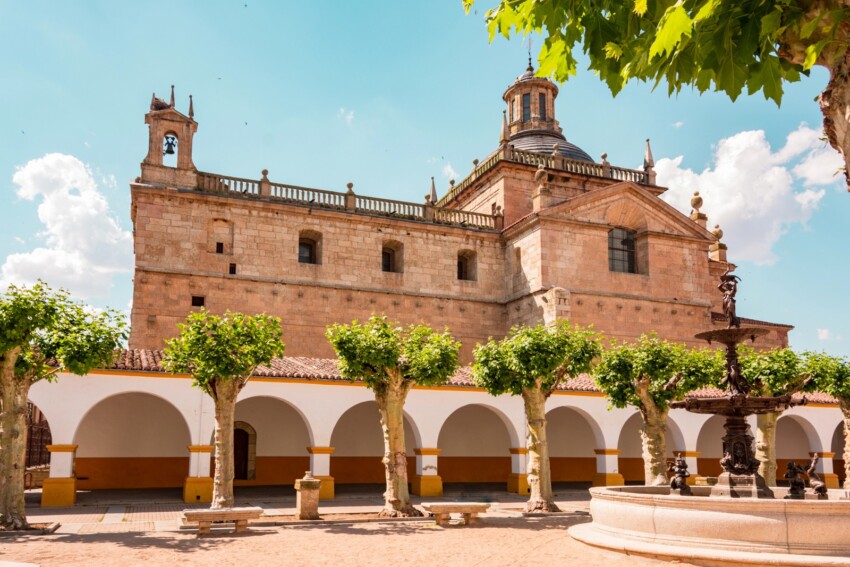
The province of Salamanca offers numerous opportunities for interesting excursions. Renting a car is recommended to explore the region.
La Alberca, Spain’s first village declared a National Historical Monument, is located 75 km from Salamanca in the Sierra de Francia. With its traditional stone and wooden houses, cobbled streets and preserved ancestral traditions, it offers a dip into authentic rural Spain.
The fortified city of Ciudad Rodrigo, 89 km from Salamanca, is an important historical centre with an impressive cathedral and well-preserved walls. Its strategic location near the Portuguese border has determined its rich military history.
The Sierra de Béjar, about 70 km from Salamanca, offers opportunities for mountain hiking and, in winter, skiing in the resort of La Covatilla. The picturesque village of Candelario is famous for its traditional architecture and charcuterie production.
The Arribes del Duero Natural Park, 100 km from Salamanca, offers spectacular canyons along the River Duero, which marks the border with Portugal. The area is perfect for birdwatching and boat excursions.
In Salamanca you can find a good variety of hotels to suit all budgets, from the budget pension to the luxury hotel. There are also many international chain hotels, recommended for business travellers or those accustomed to the comfort of this type of accommodation.
Salamanca is about 200 km from Madrid, so the easiest and cheapest way to get there is to arrive with a direct flight to the Spanish capital and from there travel by rental car, bus or train.
From Salamanca you can easily reach some of Spain’s most important cities such as Madrid, Avila, San Sebastián, Bilbao, Barcelona and some Portuguese cities by train.
What's the weather at Salamanca? Below are the temperatures and the weather forecast at Salamanca for the next few days.
Salamanca is the capital of the province of the same name, located in the Castile-Leon region. We are in the north-west of Spain, not far from the border with Portugal. The nearest Spanish cities are Valladolid, from which it is an hour and a half drive, and Madrid, which is about 2 hours and 20 minutes away.